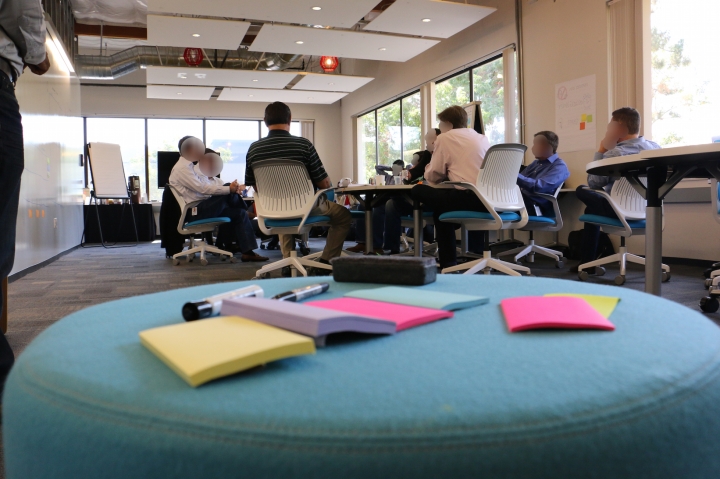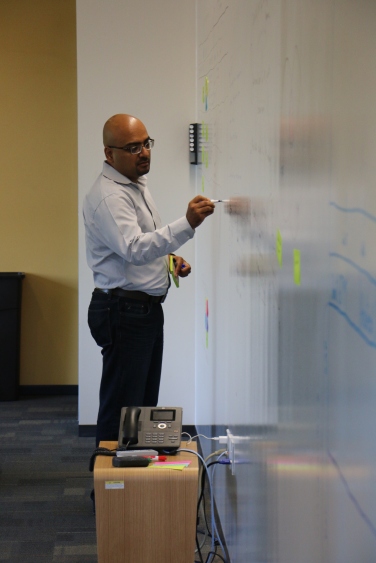With management consultants and industry experts promising to solve challenges facing organizations, how could design thinking be used to tackle strategic issues facing large and small companies?
Having orchestrated numerous such strategic engagements at SAP’s Design & Co-Innovation Center (DCC), I have a unique first hand experience of the superior value design thinking is able to generate for these organizations and their executive management team. Here is a small list of strategic issues that we have tackled using design thinking:
- Sales Strategy for achieving aggressive growth targets in an emerging region.
- Joint Go To Market Strategy:
- between two fortune 100 organizations to synergize around technological platform.
- between key players across two different industries to explore unique joint opportunities across multiple industries and multiple geographies.
- between an enterprise software player and a mobile and wearables provider to determine top areas of focus.
- around distribution and value added reseller arrangements.
- User Experience Strategy across a large organization.
- Analytics Strategy across large multi-billion dollar business.
- Operational efficiency for Oil & Gas provider.
- BIG Data Strategy for a bank.
- Patient centricity for a specialist hospital.
- Sales Innovation for a pharmaceutical manufacturer.
- Finance-operation alignment for an electric and construction equipment manufacturer.
- Account Planning and strategy for key accounts.
- Enterprise transformation for large and small enterprises, some of whom include:
- Wholesale distributor.
- Retailer.
- Soft drink bottler.
- Product and market strategy for start-ups.
So what was so different about these engagement?
First of all, instead of acting as an external “expert” preaching the management team about how to run their own business, design thinking fostered a collaborative approach in which one team spirit was facilitated across multiple lines of businesses and various levels of the organizational hierarchy. At the core was research and empathetic understanding of various stakeholders. A drastically different approach than the traditional way of tackling strategic issues.
Exploration of the problem space before thinking about the solution helped frame the discussion in ways to yield the best outcome.
Instead of focusing on merely KPIs and their fictitious futuristic projected improvements, desirability from the perspectives of key stakeholders was front and center. These stakeholders included customers, suppliers, internal employees and partners. Having the conversation around desirability kept the focus on the real value as well as building the bridges among these diverse groups!
Instead of commandments coming from the top, ideas were generated from all levels within the organization. Those closest to the ground realities and customers are generally the ones who know the real opportunity areas.
Instead of acting as external “experts”, we became genuinely curious like children. Using basic questioning techniques (such as 5 Whys, how, who, what, what if and why not), we were able to get to the bottom of issues in a quicker fashion than the traditional approach, which may take months and even then come up short.
Instead of being bogged down in the challenges of today and issues of yesterday, focus was shifted to envisioning a future that is aspirational. This focused the ideas to be forward looking. Instead of focusing on best practices, we focused on coming up with out of the box thinking to build solutions that no one has thought of before. After all, best practices are a set of practices that have worked for a particular industry in a particular line of business in the past. Competitive advantages are not established by copying what others have done in the past, it is attained by devising new ways of doing things. You’ll never be able to build sustainable competitive advantages by focusing on the past.
Bringing business, IT and other stakeholders together has the added benefit that the pace of decision-making speeds up. We balance the desirability with viability and feasibility together as a team. Prioritization is done in a swifter manner.
Rapid prototyping is incorporated during the engagement to get a feel of how the solution might look like with immediate feedback from the stakeholders.
To conclude, a goal oriented action plan is devised with ownership and timelines jointly agreed upon.
This agile approach yields far superior results than the traditional bureaucratic approach of strategy formulation as evidenced from the following testimonials from the participants:
We never thought of the perspectives that came to light during the workshop which would likely change our direction – Start-up founder
The most engaging interaction – Client Head of Strategic Planning
Excellent way to generate Ideas – Client CEO
Bringing the best out of the team – Client CIO
Amazing way to have business and IT working together to solve business problems – Client Head of Operations
The workshop was a big success … participants left with a bunch of new ideas and perspectives on what was now needed to take their business to the next level. – Director of Strategic Marketing
It was an amazing two days we spent together where ideas which were well formed got elaborated and are now everybody has now a better sense of what they need to do next. – Management Expert
These are some of examples of innovation lead business strategy formulation. If you want to learn more about leveraging Design Thinking for formulating business strategy, feel free to drop me a line.
Cheers,
Mashhood




Too long post though worth it. I wonder that how can you just write such a long post and not even boring with amazing information. Thanks!
LikeLike
Thanks for your comment, David.
LikeLike
Hi Mashhod. How is everything ?
I just saw your article and I am interested to use this subject to my MBA completion work…
Could you recommend couple books about it?
I really will appreciate !!!
Thanks and have a nice week !!!
William Oliveira – Brazil
wioliveira@gmail.com
LikeLike
Hi William,Sorry for not responding earlier; I was busy completing my book, which will be published globally next month. You may check it out at my website at http://mashhoodalam.comBesides, you may read following book:Change by Design: How Design Thinking Transforms Organizations and Inspires Innovation https://www.amazon.com/dp/0061766089/ref=cm_sw_r_cp_api_Fxk1BbRVP3DX4
LikeLike
Hi. I just read you post and I am interesting on use this subject as my MBA conclusion work. Do you have some books to recommend me? Thanks a lot.
William Oliveira – Brazil (wioliveira@gmail.com)
LikeLike
Hi William,
Sorry for not responding earlier; I was busy completing my book, which will be published globally next month. You may check it out at my website at http://mashhoodalam.com
Besides, you may read following book:
Change by Design: How Design Thinking Transforms Organizations and Inspires Innovation https://www.amazon.com/dp/0061766089/ref=cm_sw_r_cp_api_Fxk1BbRVP3DX4
LikeLike